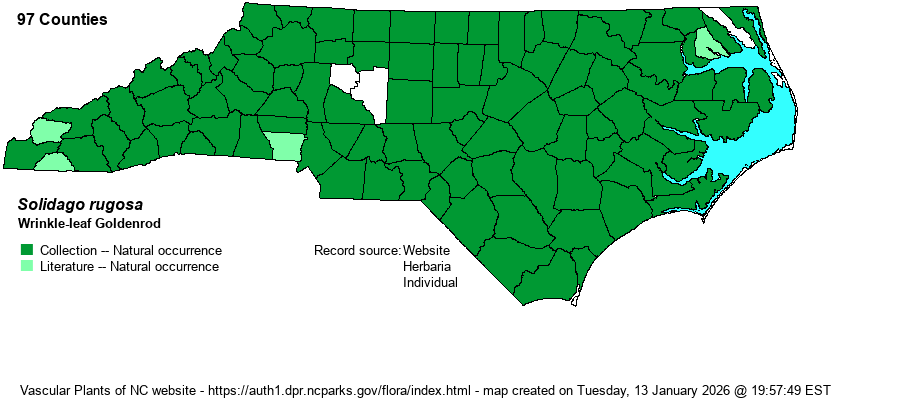| Author | P. Miller | |
| Distribution | Statewide, though less widespread in the Mountains. A recent check of all "rugosa" specimens at NCU (UNC-Chapel Hill herbarium) shows plainly that var. aspera is the most widespread and common in NC.
Southern ME to MI and IN, south to northern FL, eastern OK, and eastern TX. | |
| Abundance | Common to abundant statewide, except only fairly common to common in the central and southern Mountains. This is one of the most common goldenrods in the state. | |
| Habitat | Dry to mesic, less often moist, soils of pine-deciduous woodlands, woodland edges, forest openings, rocky slopes, fields, clearings, powerlines, roadsides. As with many widespread goldenrods, it occurs in common habitats, usually ones impacted by man. | |
| Phenology | Flowering and fruiting August - early November. | |
| Identification | In general, members of S. rugosa grow 2-4 feet tall (occasionally to 5 or 6 feet according to FNA) and have widely branching inflorescences with heads along one side of each branch. Stems often are connected via horizontal rhizomes and thus form colonies. Stems vary from densely to lightly hairy with coarse short hairs. Basal leaves are absent at flowering time; stem leaves are lance-shaped or elliptic, sessile (without a stalk), the tip pointed, margins toothed, and surfaces generally wrinkled ("rugose"), the upper surface rough (scabrous). Upper stem leaves are smaller. See the various varieties for features to identify them. A number of other full species of goldenrods can be confused with S. rugosa, but the wrinkled and/or rough upper leaf surface rules out most others, and rough or hairy stems rules out some others. | |
| Taxonomic Comments | The entities within S. rugosa have been variously treated (or ignored) in the past; our treatment follows that of FNA and Weakley (2018), except that Weakley and this website split out the very different S. aestivalis. That still leaves four varieties in the state -- aspera (statewide), celtidifolia (eastern half of the state), cronquistiana (Mountains), and the nominate rugosa (Mountains and Piedmont).
| |
| Other Common Name(s) | Rough-stemmed Goldenrod, Rough Goldenrod, Roughleaf Goldenrod | |
| State Rank | S5 | |
| Global Rank | G5 | |
| State Status | | |
| US Status | | |
| USACE-agcp | FAC link |
| USACE-emp | FAC link |

